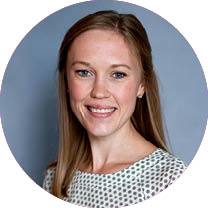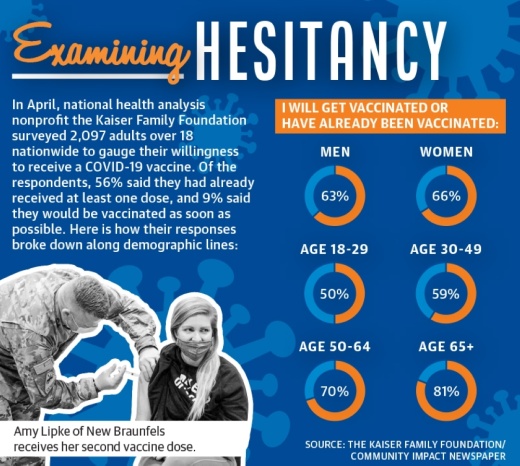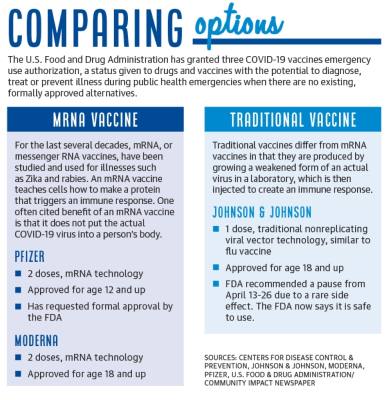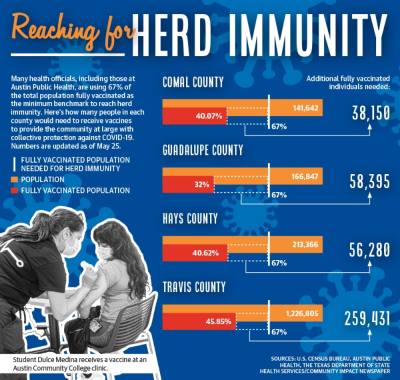Kendra Wright received early access to the coronavirus vaccine in January as an essential caretaker to her elderly father. Walking out of the appointment, Wright said she felt immediate relief.
“It was like this weight was lifted that I didn’t even know I had,” Wright said. “I instantly wanted everyone to feel that way.”
She began by helping a dozen Bee Cave community members find appointments for themselves and their loved ones. Wright was soon flooded with messages from residents, some looking for appointments and some asking how they could help.
In late January, Wright launched Kendra’s COVID Coaches—one of several Central Texas volunteer groups working to aid the region in the pursuit of reaching herd immunity, or the status at which a community at large will have collective protection against a virus. Since January, grassroots groups such as Kendra’s COVID Coaches have helped connect tens of thousands of Central Texans with vaccine appointments.
Incoming requests to the groups have dwindled across April and May, however, and the groups’ approaches have changed to meet people where they are. Wright said her team has shifted its focus to reaching residents who may be willing to get a vaccine but lack the urgency, time and access to obtain one.
In a survey conducted by Sendero Health Plans across eight Central Texas counties at the end of 2020, 64% of respondents said they would get a COVID-19 vaccine if they had the opportunity. Only 5.5% of respondents gave an unequivocal “no.”
Convincing those residents in the gray area is the goal for Central Texas health authorities, volunteer groups and physicians. Working in conjunction to reach these pockets of vaccine-hesitant Texans, they hope to boost vaccination rates past the threshold for herd immunity.
In light of emerging COVID-19 virus variants, there is pressure to reach that goal as soon as possible in what U.S. President Joe Biden has called a “life-and-death race.” As of May 27, data from the Texas Department of State Health Services stated around 40% of the U.S. population has been fully vaccinated. Some 58.9% of Americans 12 and up have had at least one dose, a percentage Biden has said he aims to raise to 70% by July 4.=
“The more we can reduce transmission right now, the more we reduce the chance of new variants, spreading and evading vaccination efforts,” said Mark Escott, Austin-Travis County interim health authority, in April.
The road to herd immunity
Officials at Austin Public Health have used 67% vaccination of the population as the minimum benchmark necessary to approach herd immunity. But the actual threshold remains unclear.
Anthony Fauci, director of the National Institute of Allergy and Infectious Diseases, has estimated herd immunity will come at a higher rate of vaccination, but at an April White House press briefing he encouraged people not to focus on specific rates.
“We’ve made estimates that it is somewhere between 70[%] and 85%, but we don’t know that as a fact,” Fauci said. “So that rather than concentrating on an elusive number, let’s get as many people vaccinated as quickly as we possibly can.”
Other experts, including Dr. Lauren Ancel Meyers, executive director of the University of Texas at Austin’s COVID-19 Modeling Consortium, a network of researchers and epidemiologists, have said that herd immunity is unlikely. Regardless, Meyers has said publicly that faster vaccination will help the virus subside by reducing the number of infections and community spread of COVID-19 and its variants. Coronavirus infections among fully vaccinated individuals are rare—only around 0.02% have proceeded to catch the virus in the Austin area, according to APH data.
Around 41.87% of Texans were fully vaccinated as of May 27. Some areas of the state that were hardest hit during the deadliest stage of the pandemic have surged ahead—El Paso, for instance, exceeded 50% fully vaccinated and has seen the average daily count of positive cases drop by 100 in the past month.
Counties in Central Texas still have a long way to go to match El Paso. Comal, Guadalupe, Hays, Travis and Williamson counties all have full vaccination rates at or below 45% as of May 27.
For Dr. Emily Briggs, head physician at Briggs Family Medicine in New Braunfels, raising local vaccination rates is essential to protecting the community from future outbreaks.
“We have to get everybody vaccinated so that those that can’t get vaccinated ... well, they can’t be protected unless everybody around them protects them by getting the vaccine,” Briggs said.
Barriers and hesitation
The FDA’s May 10 decision to expand the Pfizer vaccine’s emergency use authorization to include 12-15 year olds could help close the gap.
Dr. Andrew Cavanaugh, a pediatrician with Chisholm Trail Pediatrics in Williamson County, said his patients have shown strong interest in getting their children vaccinated. Some have also expressed doubts or distaste in surveys, but Cavanaugh said the gradual ramping up of the vaccine’s availability gave patients time to warm up to the vaccine.
“I’m kind of glad that the supply has been the way it has. In some ways, I think it’s been beneficial, because it has allowed a slow phasing in of this vaccine that people can kind of see what happened to the ‘guinea pigs,’ if you will,” Cavanaugh said.
In Comal County, 70,663 eligible residents had received at least one dose of vaccine, and 56,986 were fully vaccinated as of May 27, according to DSHS. Guadalupe County reported 65,167 residents who had received at least one dose and 53,096 who were fully vaccinated.
Carl Carlson, a resident of New Braunfels, said he and his wife chose to wait to be vaccinated until the single-dose Johnson & Johnson vaccine became widely available locally. Because Carlson’s wife uses a wheelchair and is at high risk for complications should she contract COVID-19, they wanted to be sure they would not have to wait in a long line or coordinate a second visit to be vaccinated.
“We decided, since my wife is dependent on me, to stagger our shots so I wouldn’t be suffering potential side effects at the same time she is,” Carlson said.
Though many of Carlson’s friends and family have been vaccinated, he said that some still remain skeptical and do not plan to be vaccinated.
According to an April survey conducted by the Kaiser Family Foundation, 15% of unvaccinated respondents said they would wait and see how the vaccine affected others, and 18% said they will only get the vaccine if required or will definitely not receive the vaccine.
In order to combat vaccine hesitancy, Briggs and a group of physicians in New Braunfels partnered with New Braunfels Utilities to produce a video addressing myths and misconceptions regarding the vaccine and provide answers to commonly asked questions.
One myth the video addressed is the idea that someone who has previously been infected with COVID-19 has strong natural immunity.
“We have had significantly ill people who have survived the virus then get ill again with another round of it, especially with these variants,” Briggs said. “We can’t consider people that have not been vaccinated to be immune.”
The video has since been shared with the city and other local entities, according to New Braunfels Mayor Rusty Brockman, and is available for residents to view when making their decision regarding vaccines.
“I think what we’ve seen over the last 14 months is how divisive social media can be with wrong information getting spread,” Brockman said. “And so I think it’s really extremely important that we continue to be vigilant to getting the right, accurate, current information out to our community.”
As health care providers and area officials continue encouraging residents to get vaccinated, many face the additional challenge of ensuring their patients receive their second dose for either the Moderna or Pfizer vaccine, as recommended by the Centers for Disease Control and Prevention and the U.S. Food and Drug Administration.
Dr. David Gude, Texas MedClinic chief operating officer and a practicing physician, said that no-show rates for second dose appointments at the group’s 19 clinics throughout Central Texas have increased from 5% to 12%-15% in recent weeks.
“They don’t come back to us for their second dose,” Gude said. “Maybe they found other places to get their second dose that was just more convenient.”
Officials at Guadalupe Regional Medical Center have seen similar trends, according to Chief Operating Officer Sheri Williams. As vaccines have become more widely available, some residents chose to receive their second dose elsewhere, while others have missed their second dose altogether, she
said.
Vaccine-hesitant individuals’ reasoning varies. Wendy Pendergast, a Lakeway resident, told Community Impact Newspaper she thinks her body can fight off COVID-19 and has concerns about long-term side effects of the vaccine, although large-scale clinical trials have shown side effects mostly to be brief and mild. Others cited more logistical barriers. Betty Kent, a 65-year-old New Braunfels resident, received her first dose of the Moderna vaccine and had flu-like side effects that caused her to miss five days of work.
“I will not return for the second shot,” Kent said. “No one paid me, and I had to suffer so with my bills, [so] I will just take my chances.”
Building access
For some Central Texas residents, accessibility has proven the key to making a vaccine appointment.
With access in mind, Texas MedClinic has expanded vaccine appointments at each of its clinics to give residents more opportunities to receive their shots.
“A lot of people simply don’t have the ability to take off from work for an hour or two to get a dose of vaccine,” Gude said. “By spreading [appointments] out and hopefully having evenings and weekends, we will be able to reach a whole different section of the population.”
Members of the New Braunfels Fire Department have partnered with the county to offer vaccines to homebound patients who could not attend a mass-vaccination clinic or other vaccine provider.
“Chief [Patrick] O’Connell has worked with the county public health office to be able to get all of his EMS troops certified up to be able to give those vaccinations,” Brockman said.
The city of Seguin, the Guadalupe County Emergency Management Department and GRMC partnered earlier this year to create mass-vaccination clinics and have since shifted their focus to smaller-scale options.
“We have done some smaller industry ones around here, and some of the city paramedics have gone into people’s homes and done them individually,” Williams said.
Wright and her team at Kendra’s COVID Coaches have gone directly to businesses, reaching out to encourage them to allow residents time off to get vaccinated and recover from any potential side effects, a privilege not afforded to many essential workers.
“When you start feeling like you’re probably moving the needle because you’ve helped so many people, you just can’t help but want to do more of it,” Wright said.








